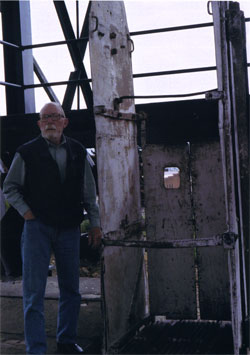Work Song Background Notes
Work Song is a return to the story of Morris Morgan, one of the central characters of your bestselling 2006 novel, The Whistling Season. What compelled you to return to this character and his story?
With his golden tongue and quicksilver mind, Morrie has turned out to be such a treasure for a writer that I figured it would be a mistake not to welcome him back onto the page. After his performances of mental magic in the one-room schoolhouse of The Whistling Season, countless of the readers who made that book a runaway hit remarked to me, "Oh, I wish I'd had a teacher who could talk like that." It seemed only natural for such a compelling voice to take over the telling of this next story. By now, I'm not sure which of us is the ventriloquist: Morrie or me.
Why did you take him to Butte?
 |
|---|
Author at Anselmo Mineshaft |
In its copper heyday, Butte and its "richest hill on earth" were unique; more than a mining town, it was the largest city of the northern Rockies, straining to be cosmopolitan, with mile-deep mineshafts directly beneath its busy streets. The place saw itself as self-made, tough, and proud--never short on attitude; as Morrie notices, when people say they're from Butte, their chin comes up an inch on the word.
Why 1919? It was a time full of trouble, always a lure for a novelist. The period just after World War One was terrifically contentious in America, with labor strife, fear of domestic Bolshevism, and government and Wall Street suppression of dissent. Butte with its mineral wealth and rock-hard miners, many of them foreign born, was a crucible of all that. It's a setting where characters hear the big questions of life in their sleep, in the round-the-clock workings of the mines on the famous and infamous hill.
Writers endlessly have called Butte in its smoky industrial heyday "the Pittsburgh of the West," but Morrie and I prefer to dub it "the Constantinople of the Rockies" because it was such a colossal mix of peoples. Hard-rock miners from several nations came seeking some of the best wages in the world on that "richest hill," and in blood-bound habit they formed their own neighborhoods--Dublin Gulch for the Irish, Meaderville for the Italians, not be confused with Centerville for the Cornish, Finntown self-explanatory, and so on. This simmer of nationalities inevitably added to the heated labor atmosphere of the time.
What was it like to research this novel?
To me, research is like that dark mysterious hill that stands over Butte and its great era--I know valuable stuff is there, but it takes a lot of digging.
On the large scale, I take great care that my characters and their circumstances are subject to the laws of historical gravity--in this novel, the bootleg bottle in a coat pocket at an Irish wake is a Butte fact of life a year before national Prohibition because Montana had voted itself dry, for instance.
The finer details, what I call the slow poetry of fact, simply have to be gathered one by one, like nuggets. This meant spending time in Butte, traipsing around to the old mine sites--in near-freezing weather, in June!--to find what my characters would have experienced nearly a century ago, such as the phone booth-size elevator that plunges Morrie to the blandly named "thirty hundred level"--i.e., three thousand feet beneath the surface of the earth. The crystallizing details I seek are often in some obscure record of the past--where Google doesn't go, or at least hadn't gone yet when I was doing my research. One of my best finds began with a single photo at the bottom of a pile in a historical archive. I had gone through many, many photos showing miners at work and people of the time in their downtown clothes, but this one picture with nobody in it caught my imagination. It featured the Butte Public Library of the time, a wonderful architectural show-off--a gray granite extravaganza with arched doorways and a balcony and a peaked tower like a castle. Just the kind of place, I knew at once, where Morrie would go to consult the city directory for some job worthy of his unique talents and fall in love with "the finest book collection west of Chicago." A visit to the current Butte library brought forth a file folder of yellowed newspaper clippings which showed what the old library looked like inside--and as if that wasn't enough, the librarians took down from the wall a framed photo of the glorious old Reading Room and duplicated it for me.